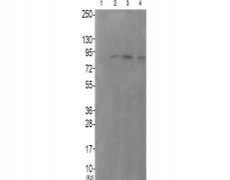中文名称:兔抗AR(Phospho-Tyr363)多克隆抗体
|
Background: |
The androgen receptor gene is more than 90 kb long and codes for a protein that has 3 major functional domains: the N-terminal domain, DNA-binding domain, and androgen-binding domain. The protein functions as a steroid-hormone activated transcription factor. Upon binding the hormone ligand, the receptor dissociates from accessory proteins, translocates into the nucleus, dimerizes, and then stimulates transcription of androgen responsive genes. This gene contains 2 polymorphic trinucleotide repeat segments that encode polyglutamine and polyglycine tracts in the N-terminal transactivation domain of its protein. Expansion of the polyglutamine tract causes spinal bulbar muscular atrophy (Kennedy disease). Mutations in this gene are also associated with complete androgen insensitivity (CAIS). Two alternatively spliced variants encoding distinct isoforms have been described. [provided by RefSeq, Jul 2008] |
|
Applications: |
WB |
|
Name of antibody: |
AR(Phospho-Tyr363) |
|
Immunogen: |
Peptide sequence around phosphorylation site of tyrosine 363 (D-Y-Y(p)-N-F) derived from Human Androgen Receptor. |
|
Full name: |
androgen receptor |
|
Synonyms: |
KD; AIS; TFM; DHTR; SBMA; HYSP1; NR3C4; SMAX1; HUMARA |
|
SwissProt: |
P10275 |
|
WB Predicted band size: |
99 kDa |
|
WB Positive control: |
Huvec cells, COS7 cells and JK cells lysates |
|
WB Recommended dilution: |
500-1000 |

 购物车
购物车 帮助
帮助
 021-54845833/15800441009
021-54845833/15800441009
